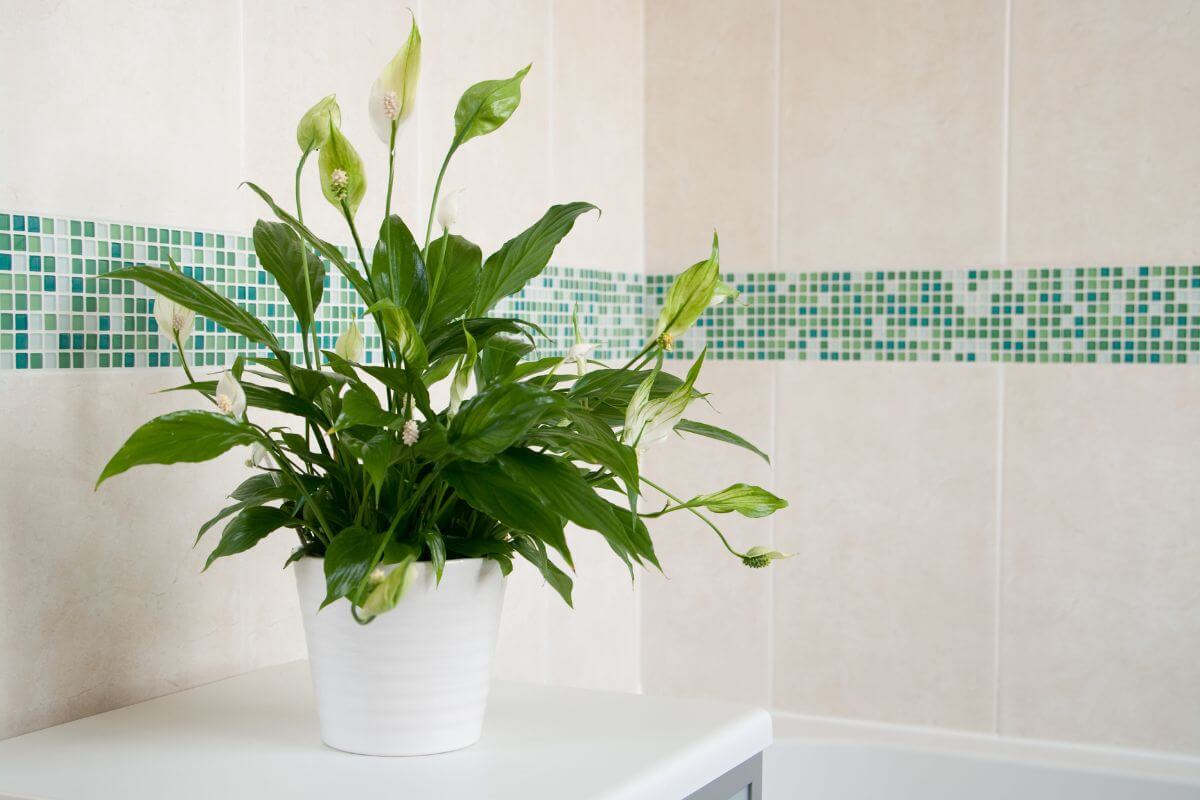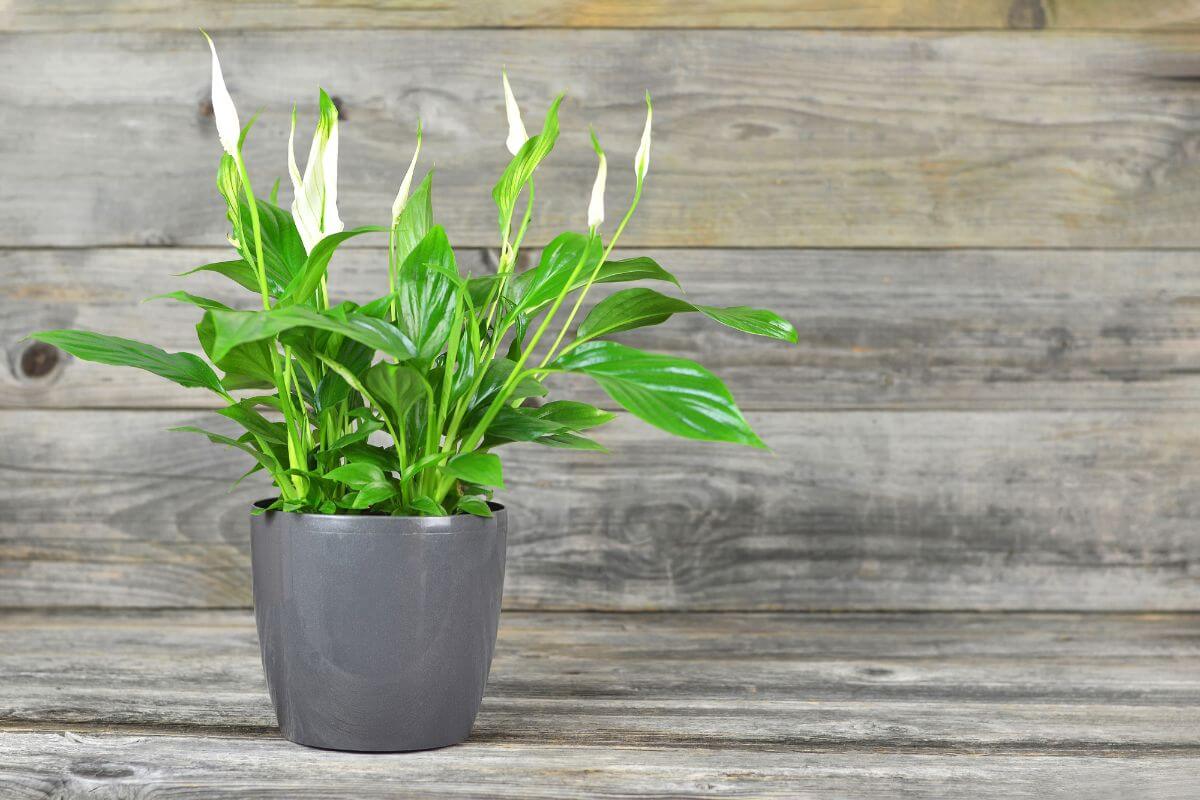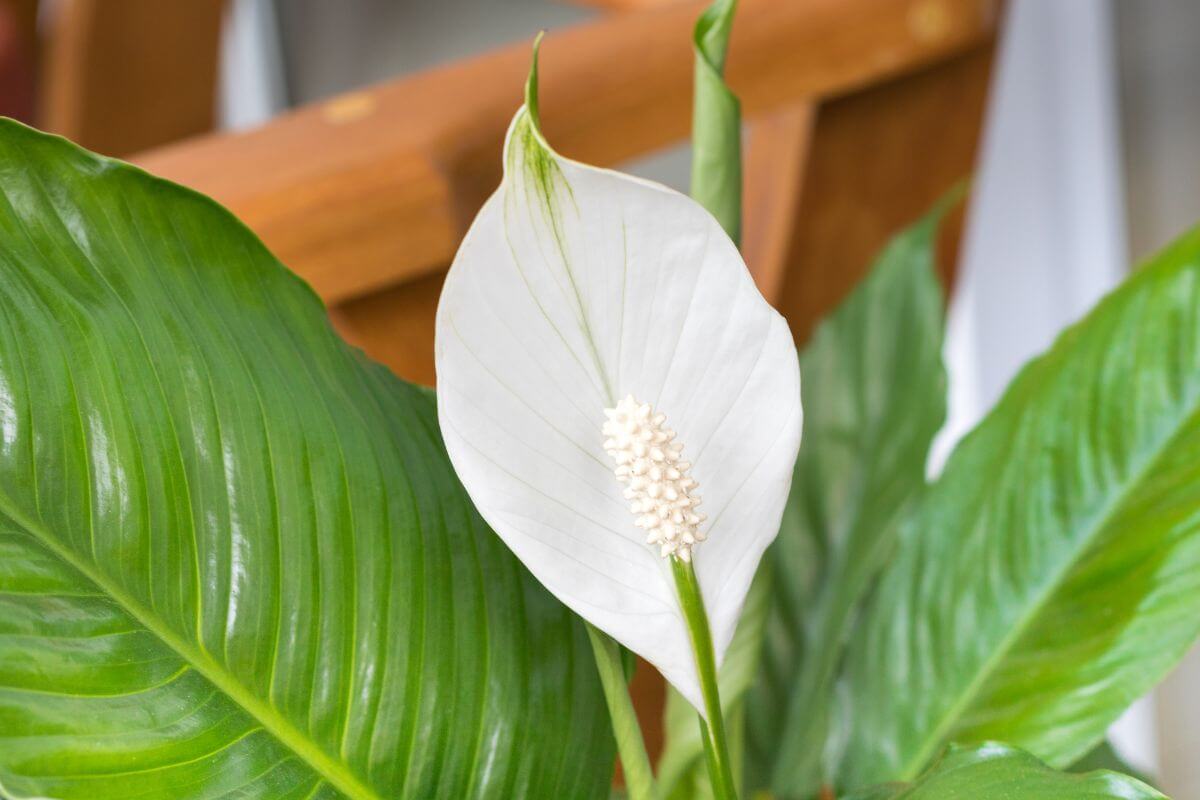Have you ever looked at a lush green plant with beautiful white flowers and wondered how to keep it healthy? Peace lilies are popular houseplants that can brighten up any space. But caring for them can be trickier than it looks.
In this guide, you will find simple tips for taking care of these air-purifying plants, like the best light conditions and how to water them properly. We’ll also talk about common problems, such as yellow leaves and dealing with pests.
Are you ready to learn how to care for peace lilies? Let’s find out the secrets of these lovely plants so your home or office can enjoy more natural beauty and cleaner air.
- Related article: Houseplant Species Overview
7 Key Takeaways on How to Care for Peace Lilies
- The Peace Lily is a low-maintenance houseplant known for its beautiful white blooms and air-purifying abilities.
- Peace lilies thrive in well-draining, slightly acidic soil and prefers indirect light, avoiding direct sunlight to prevent leaf burn.
- Water Peace Lilies once a week, keeping the soil consistently moist but not soggy, and adjust watering frequency with the seasons.
- Fertilize with a balanced, water-soluble fertilizer during the growing season, but avoid over-fertilizing to prevent brown spots on leaves.
- Peace Lilies are sensitive to pests but can be treated with insecticidal soap; regular leaf cleaning helps maintain their health.
- Peace lilies are toxic to pets, so keep it out of reach to prevent ingestion and potential irritation from calcium oxalate crystals.
- Peace Lilies can thrive indoors with proper care, making them a popular choice for home and office decor.
General Overview of the Peace Lily

The peace lily plant is not a true “lily,” contrary to what its common name would imply. It actually belongs to the Araceae family of plants. It is a tropical plant and hybrid. It’s also related to other popular houseplants such as the anthurium or the philodendron.
However, it does look a bit like lilies which explains its common name. The white flower that blooms, resembles a calla lily featuring a white spathe or sheath that looks like a hood.
One of the peace lily’s biggest benefits is its ability to purify indoor air. It’s known for breaking down harmful pollutants such as carbon monoxide and formaldehyde. For allergy sufferers, this plant can help improve air quality, as it was listed as one of NASA’s Top Ten Household Air Cleaning Plants (source).
| Characteristic | Details |
|---|---|
| Scientific Name | Spathiphyllum spp. |
| Type | Evergreen perennial plant |
| Leaf Description | Glossy, dark green leaves |
| Leaf Size | 12-18 inches (30-45 cm) long; 3-6 inches (7-15 cm) wide |
| Growth Habit | Clumping habit from the base |
| Flower Structure | White spathe surrounding a central spadix with tiny true flowers |
| Height | 1 to 4 feet (30-120 cm) indoors |
Popular Peace Lily Varieties
Some popular peace lily varities include:
- Spathiphyllum ‘Petite’ (Power Petite)– Small or petite version that will grow to only about 15 inches.
- Spathiphyllum ‘Golden Delicious’ – Features golden greenish new growth.
- Spathiphyllum ‘Mauna Loa Supreme’ – Common type that will grow from three to four feet tall with large leaves up to 9 inches in width.
- Spathiphyllum ‘Sensation’ – The largest variety that will grow to six feet in height with 20-inch-wide leaves.
- Spathiphyllum ‘Starlight’ – Has multiple blooms and narrow wavy leaves.
Peace Lily Care Guide

Like all house plants, a peace lily, will require a certain amount of water and light to guarantee its health and survival. Let’s keep this lovely plant happy.
Soil Requirements for Peace Lily
Any all-purpose loose potting soil that contains organic material and is well-draining will be a fine choice for peace lilies. Soil should be a bit acidic with the pH between 5.8 and 6.5.
Soil should remain moist but should never be waterlogged or soggy. The peace lily shouldn’t be in dry soil either. Good watering practices are discussed below.
An annual repotting in the spring will keep your plant healthy and prospering. Should your plant grow too large for its pot, you can decide whether to move it to a larger container or to divide it.
- Learn more: Peace Lily Repotting Tips
Temperature Requirements for Peace Lily
Peace lilies will flourish if the indoor temperatures average somewhere in the neighborhood of 70° Fahrenheit (21 °C). They will not do well in rooms where temperatures fall beneath 40 degrees.
These plants are not cold-hardy plants. They’re tropical, evergreen plants that like humid climates and warm conditions.
If you work or live in an area with a colder climate and your office or home isn’t well heated, consider this before selecting a peace lily. If your office is only heated during the day and the heat is turned off overnight, make sure the temperature doesn’t go below 45 °F (7.22 °C).
They also do not do well with any type of cool or cold drafts. Placing the peace lily near a door or window that is continually opened and closed, especially if located in a colder climate region, is not encouraged (source). They also should not be positioned near any kind of heater or air conditioning unit as it can get too hot.
During the dry, winter months, you can also get a humidifier to increase the humidity. Check out this article on the best humidifiers for plants for some great considerations.
Light Requirements for Peace Lily
Good plant care for your peace lily will ensure that the plant flourishes and lives a long life. These plants prefer shade or at least partial shade, and should avoid direct afternoon sunlight.
They do manage well in fluorescent lighting and are even able to flourish in an area that has no windows, living up to its Closet Plant name.
If the peace lily develops yellow leaves, it has probably been getting too much direct light. Peace lily browning leaves or streaks indicate burnt/scorched leaves because of too much direct sunlight exposure.
Should brown leaves appear at the plant’s base, it may just be reacting to new leaves that are beginning to sprout.
Water Requirements for Peace Lily
For your peace lily, aim to water once a week, keeping the soil consistently moist. During warmer months, increase watering, and reduce it in late winter. Misting the leaves with distilled water can also help during the summer.
Watch for drooping leaves, indicating a need for water. If they lie flat, water immediately; your plant will perk up quickly. To water effectively, do so under a faucet, allowing excess water to drain.
If the soil is powder-like, it’s too dry; if it forms a ball that squeezes water, it’s too wet. A moisture meter can also help prevent overwatering.
For chlorine-heavy tap water, let it sit overnight or use filtered water to protect your peace lily.
Fertilizers for Peace Lily
A peace lily will not require an exorbitant amount of fertilizer. Any good organic houseplant fertilizer that is water-soluble with a 20-20-20 balance should do the trick.
Fertilizer should be added if the plant is growing or blooming in the spring and summer. Three feedings during an entire growing season will suffice. Fertilizing in the cold winter air should be avoided.
Should you want to fertilize more often, your fertilizer should be very diluted. If you overfeed the peace lily, it may develop brown spots on the leaves and brown leaf tips.
If there are more green flowers, weak-looking flowers, or a lack of flowers, instead of the typical white stately flowers, it’s a sign of too much fertilizer. Avoid applying fertilizer to soil when it is dry to prevent scorching the roots. Watering after fertilizing helps to distribute the nutrients evenly in the root area.
Peace Lily Bloom Cycle

The normal bloom cycle is once a year, although some varieties of the peace lily may bloom more. If you wish to encourage blooming, try these practices:
- When blooms die, cut and remove the bloom stalk at its base.
- Avoid stress. A well-followed watering and fertilizing program will contribute to avoiding and reducing stress.
- Consider changing the temperature. An ideal temperature will sit in the low seventies Fahrenheit. If you can drop the temperature to the mid-fifties Fahrenheit for approximately 20 days, this will stimulate blooming.
Peace Lily Pests and Diseases

Peace lilies demonstrate resistance toward diseases and plant pests. They can be invaded by aphids, mealybugs or spider mites.
To get rid of the pests, you can try a plant insecticide spray. Something like this Natria Insecticidal Soap will work.
You should keep in mind that peace lilies can be sensitive to chemicals, so any treatment should be applied sparingly.
Keeping the soil moist and well-nourished will help avoid pest infestations. You can also wipe the leaves at regular intervals to clean and help keep the glossy leaves shining.
Do avoid commercial leaf shine products as they can hurt the leaves by clogging its pores.
Brown tips on the leaves may mean several things, including:
- Excessive watering – In this case let the plant dry out and then water on a schedule.
- Excessive fertilizing – Fertilizer should be used in the growing season only.
- Aridness or too little humidity – You can provide leaves with more humidity by applying a mist of water that is distilled.
Learn more about why peace lily leaves are turning brown.
Wilting in your peace lily can signal thirst, transplant shock, or overwatering. If it’s due to transplanting, give it time to adjust; if overwatered, allow the soil to dry before resuming a regular watering schedule. A rootbound plant may also appear droopy and show minimal growth.
Is the Peace Lily Poisonous to House Pets?
ASPCA (American Society for the Prevention of Cruelty to Animals) indicates the peace lily as a poisonous plant for domestic pets, including both dogs and cats (source).
Peace lilies contain calcium oxalate crystals, which can irritate the digestive system and mouth of cats and dogs. Symptoms include excessive salivation and swelling of the mouth. Fortunately, most pets will stop chewing after the first bite, reducing the risk of severe harm.
To keep cats safe, place the plant out of reach or use coffee grounds as a deterrent. For dogs, training them to avoid the plant is essential. If you notice any symptoms of oxalate poisoning, take your pet to the vet immediately for care.
- Read more: Are Peace Lilies Toxic to Dogs?
Peace Lily Plant Care Final Thoughts
The peace lily is an excellent houseplant that is easy to care. It’s a common houseplant that’s often chosen to decorate homes and offices among their collection of houseplants.This easy-to-grow indoor plant is also a fan favorite as the ideal gift plant for friends and family.
This flowering plant is a low maintenance, resilient plant that revives speedily if it goes for a couple of days without adequate water. It thrives and flourishes with minimal light, and it offers a stronger immunity to pests and diseases than many other types of plants.
For other houseplant care guides, here are some other popular articles:
Peace Lily Plant Care FAQs
1. How Much Indirect Light Do Peace Lilies Need?
Peace lilies thrive in bright, indirect light conditions. While they can tolerate low light, too much direct sunlight may cause pale leaves and reduced white blooms. Ideally, place your plant near a window where it can receive filtered light for optimal growth.
2. How Should I Water Peace Lilies?
Water peace lilies when the top inch of soil feels dry. Frequent watering is necessary, but avoid overwatering, which can lead to root rot. Make sure that the potting mix drains well, allowing the root ball to breathe while keeping the soil consistently moist.
3. What Do I Do About White Flags on My Peace Lily?
White flags on peace lilies often indicate that the plant is stressed. This can occur due to cold temperatures or insufficient light conditions. To remedy this, move your plant to a warmer spot with bright, indirect light to promote healthy growth and blooms.
4. Why Are My Peace Lily’s Leaves Pale?
Pale leaves on a peace lily can result from inadequate light or nutrient deficiency. Ensure your plant receives bright, indirect light to promote healthy green foliage and vibrant white blooms. Additionally, consider fertilizing every few months to replenish essential nutrients in the potting mix.
5. How Can I Encourage White Blooms on My Peace Lily?
To encourage white blooms, provide your peace lily with bright, indirect light and maintain consistent moisture in the soil. Make sure the potting mix drains well and avoid letting the plant sit in cold temperatures, as this can hinder blooming and overall plant health.
For other houseplant care guides, here are some other popular articles:






